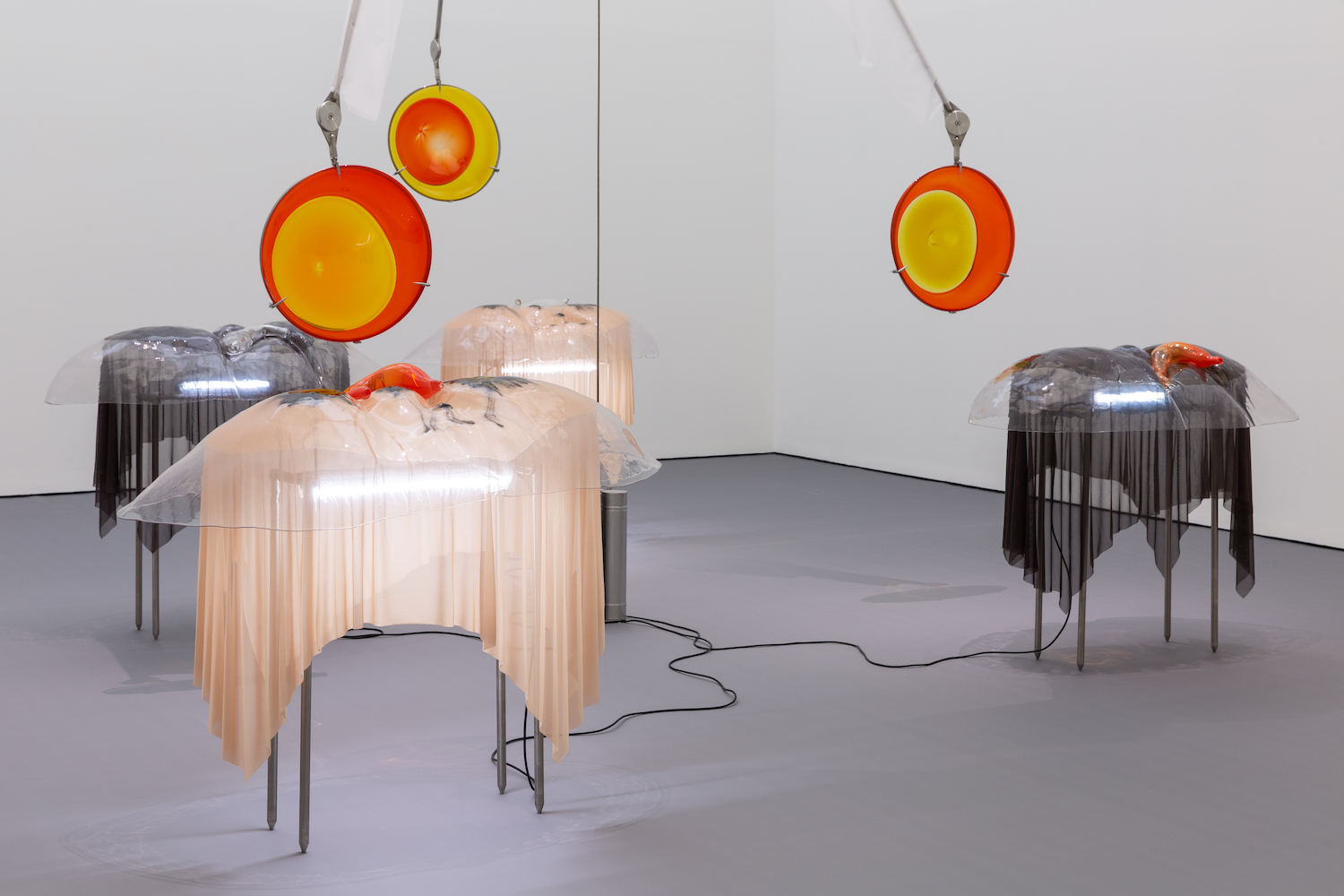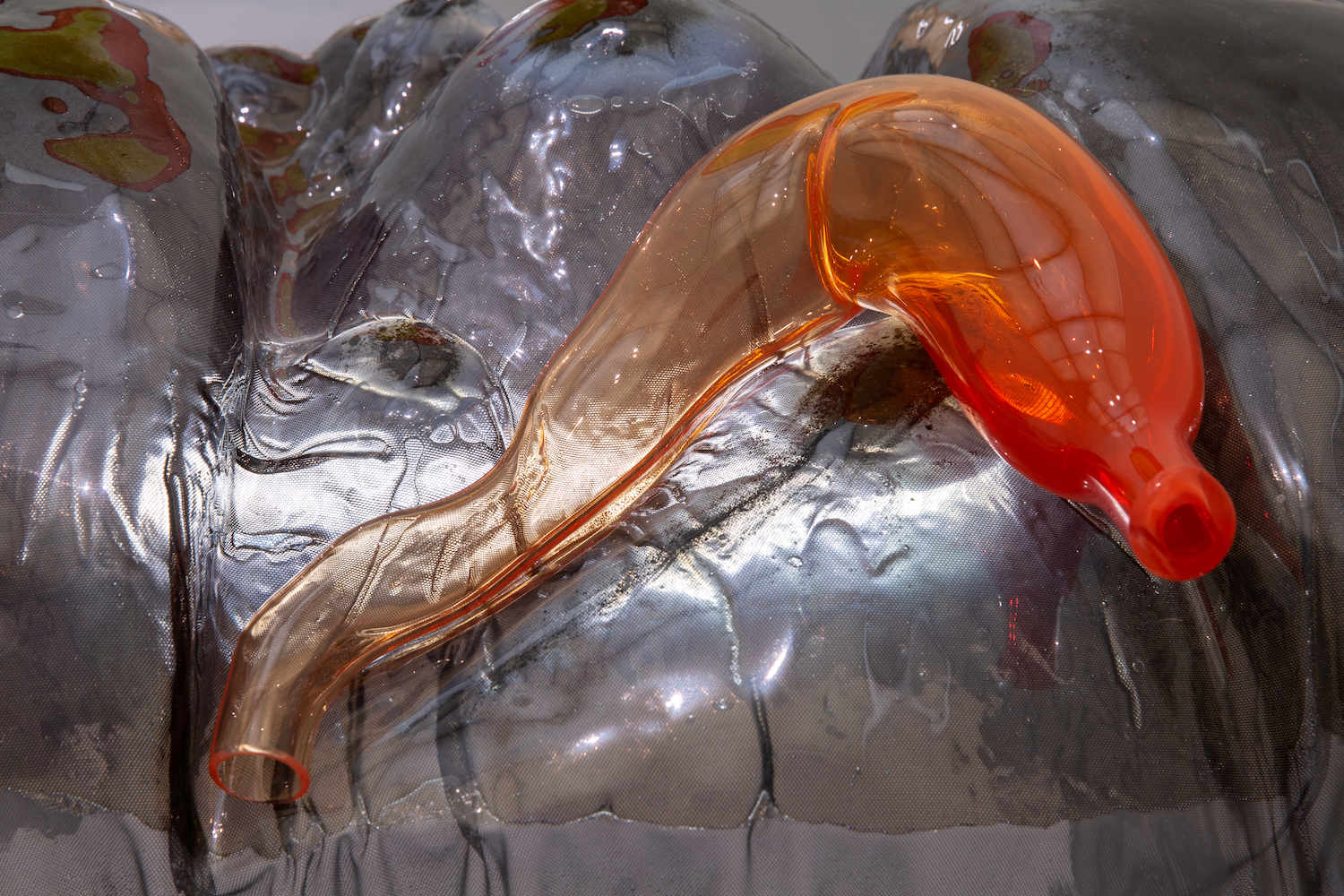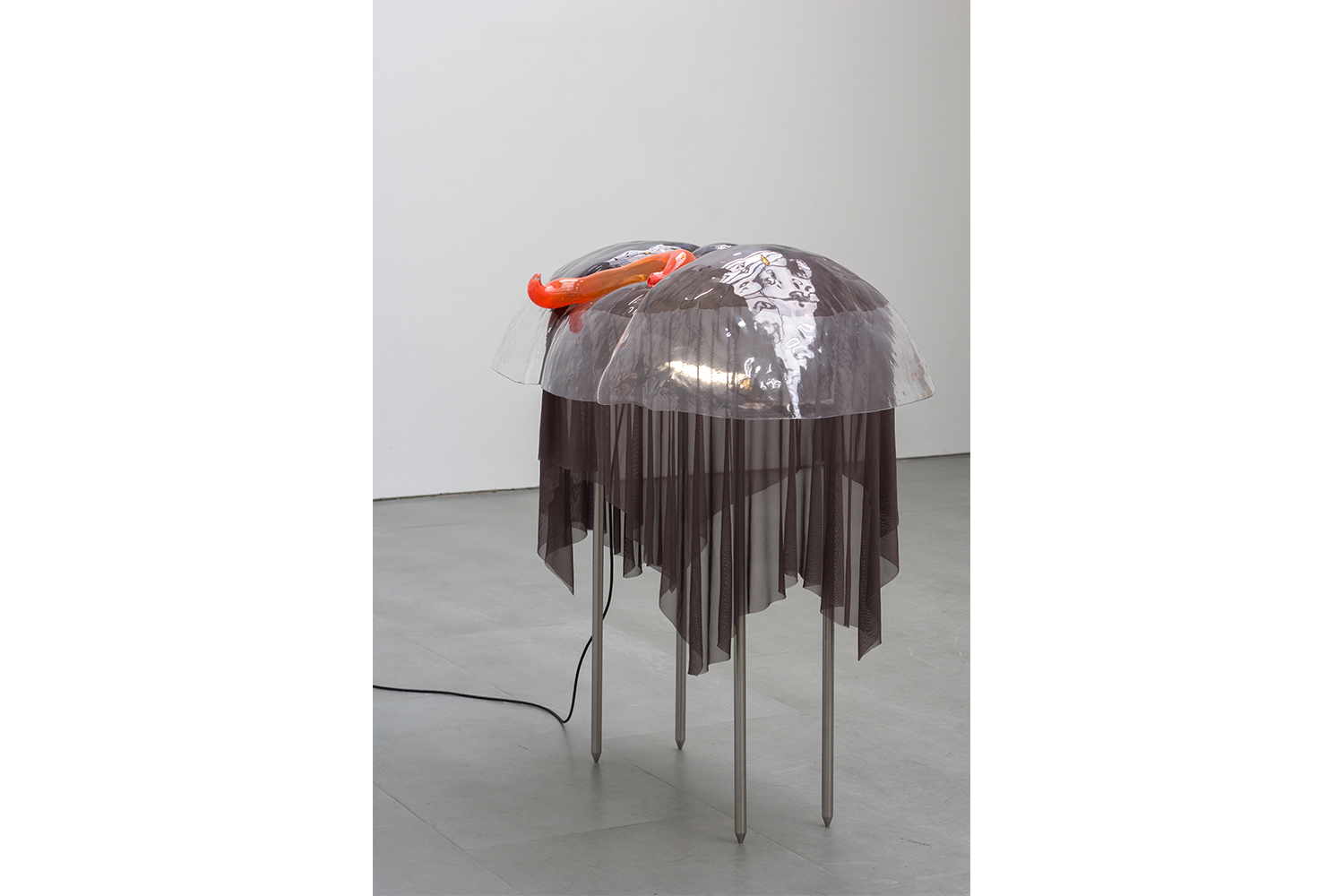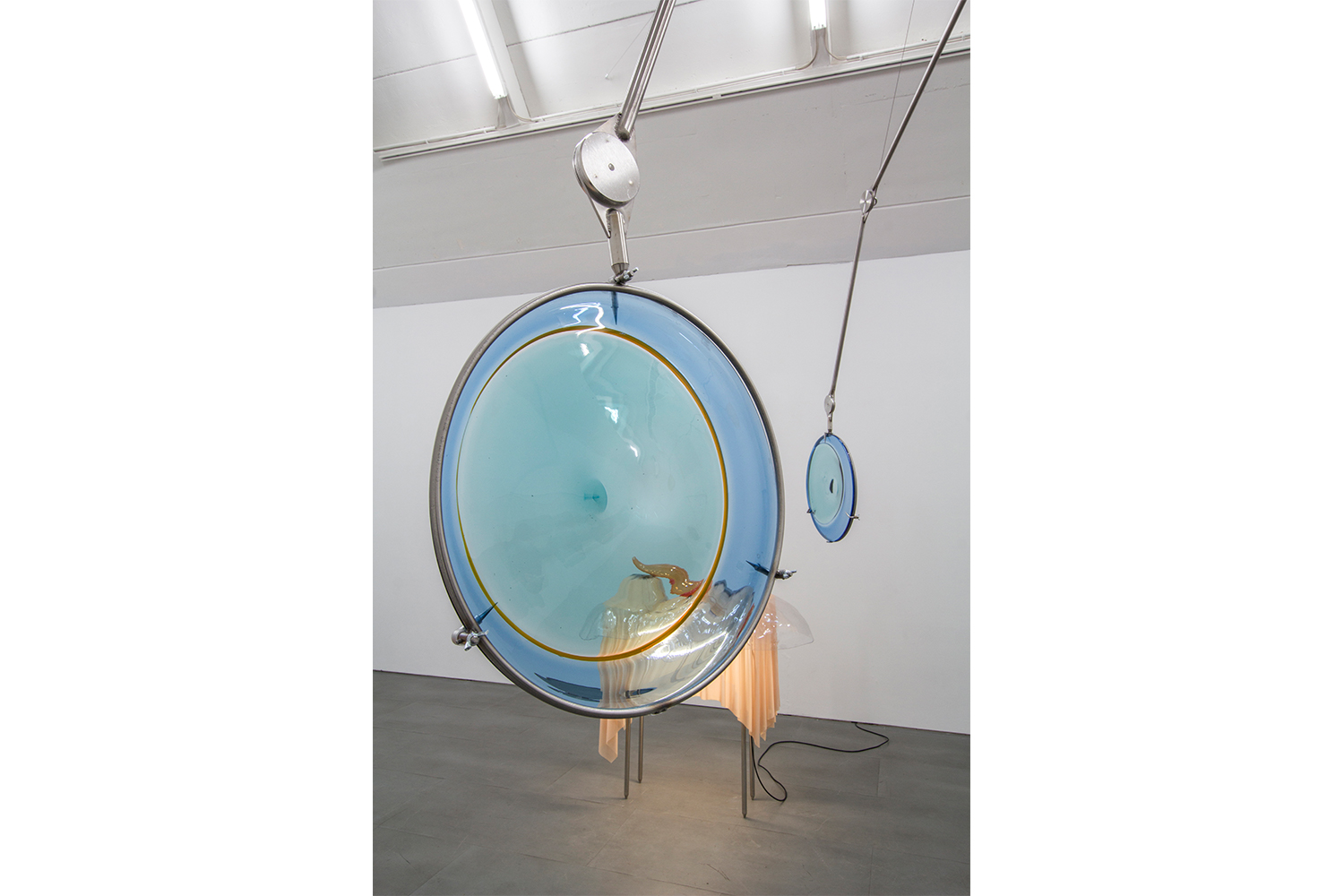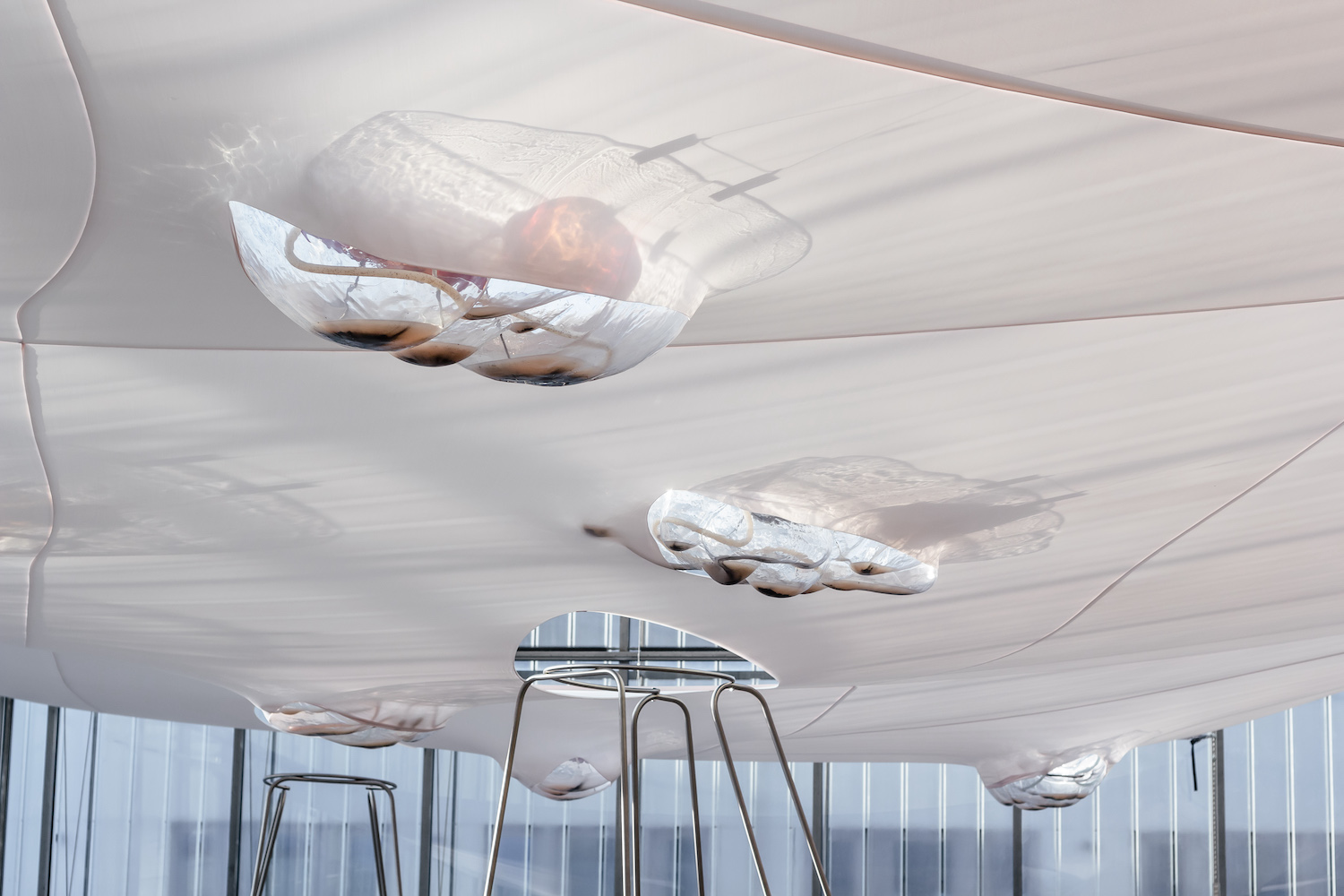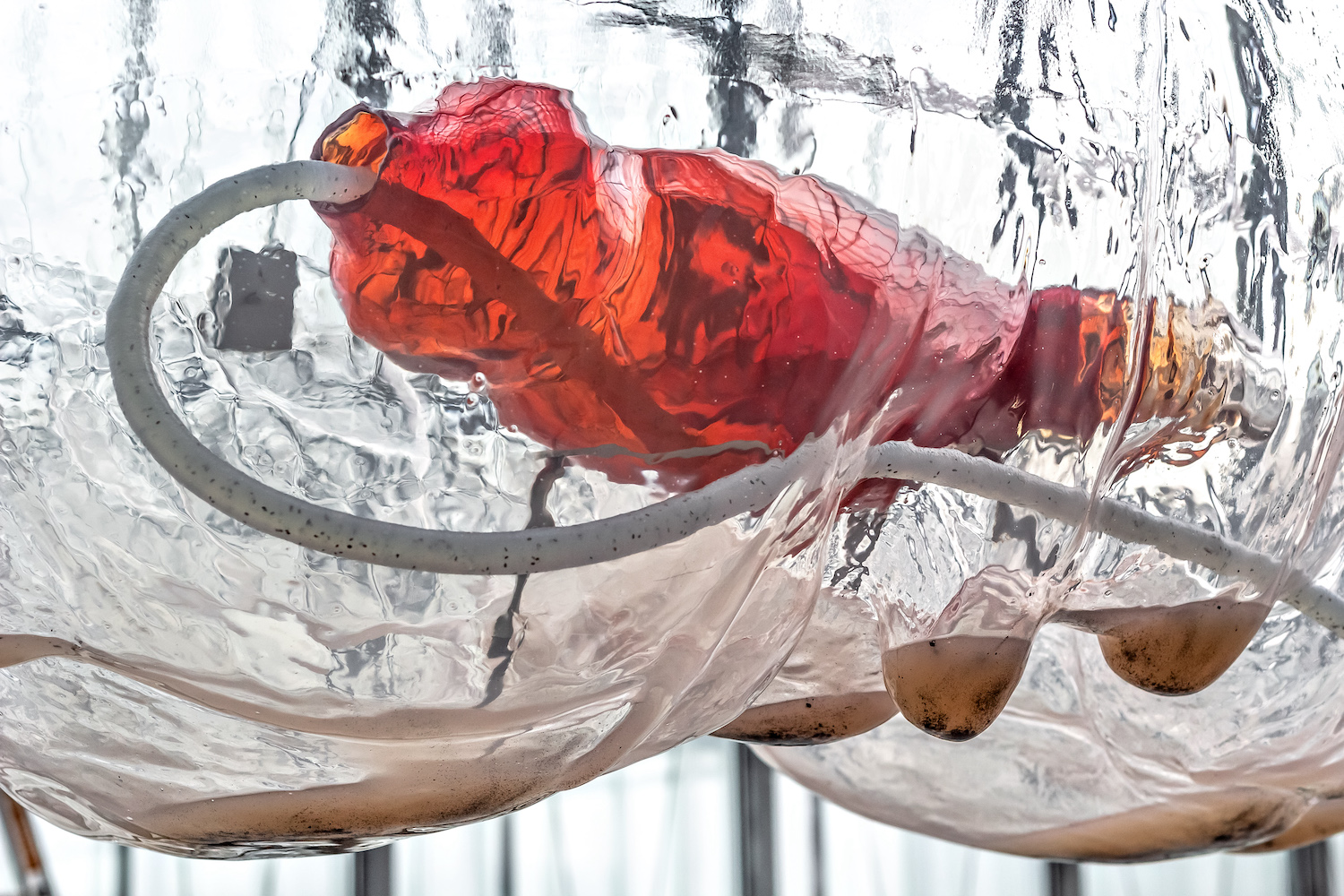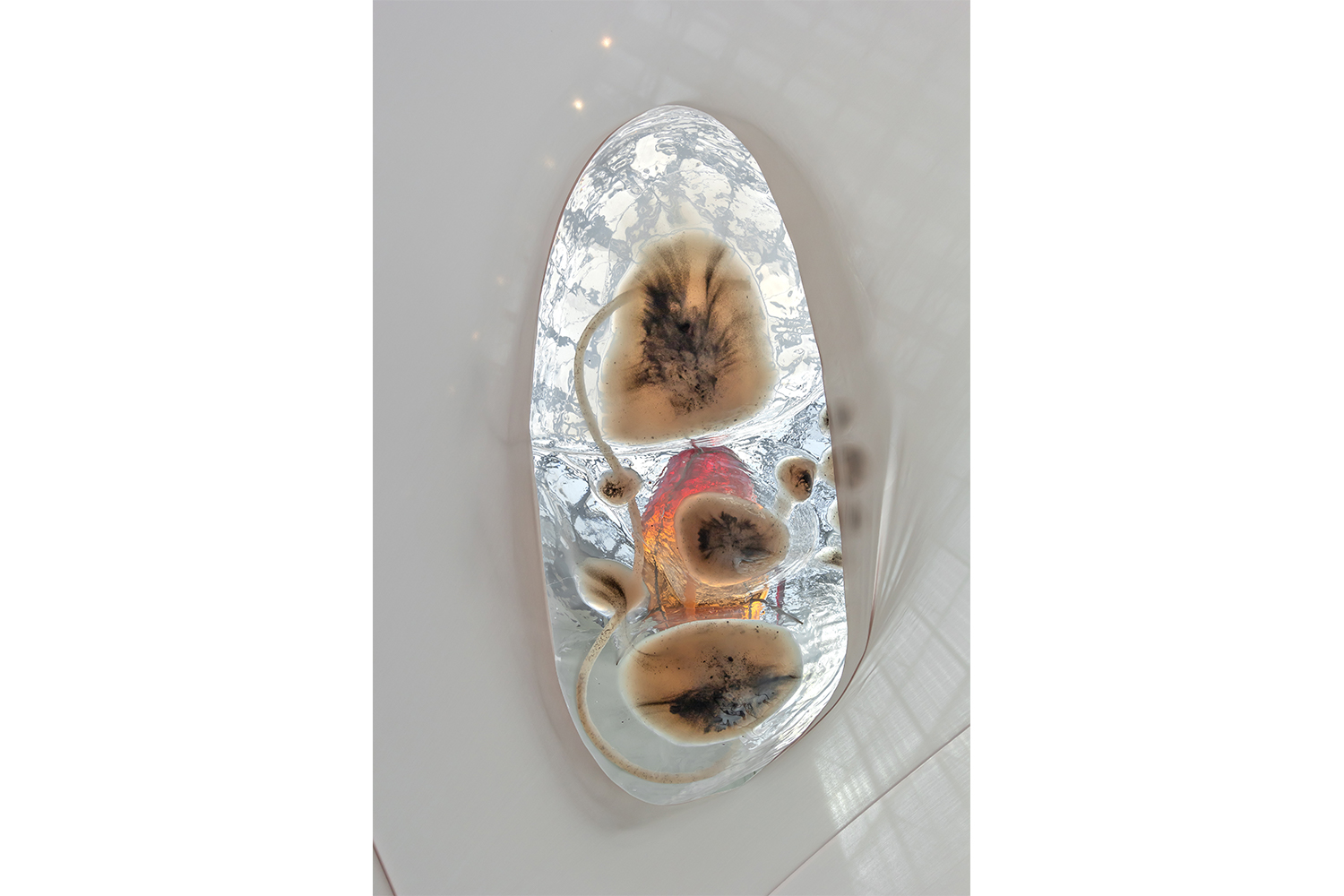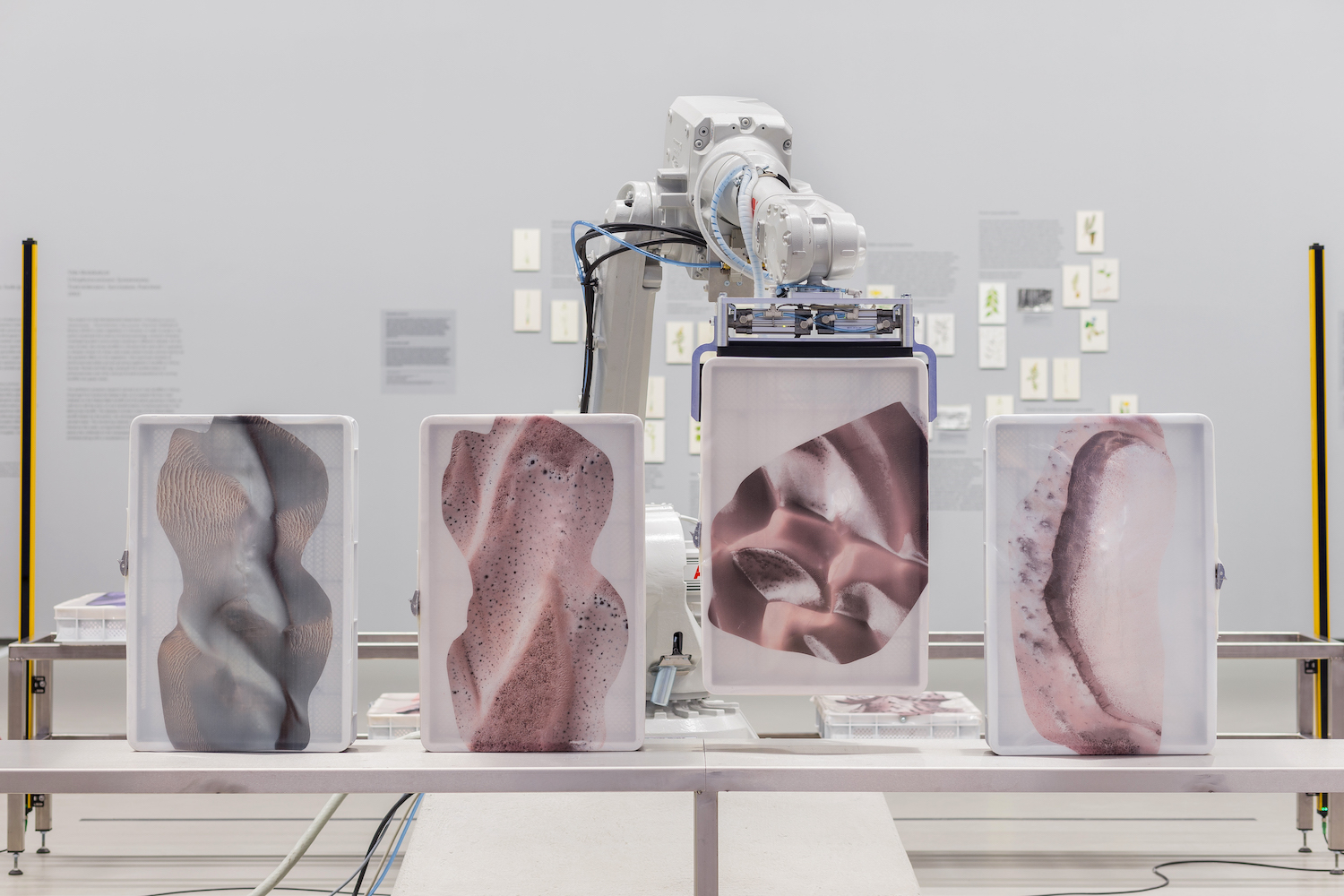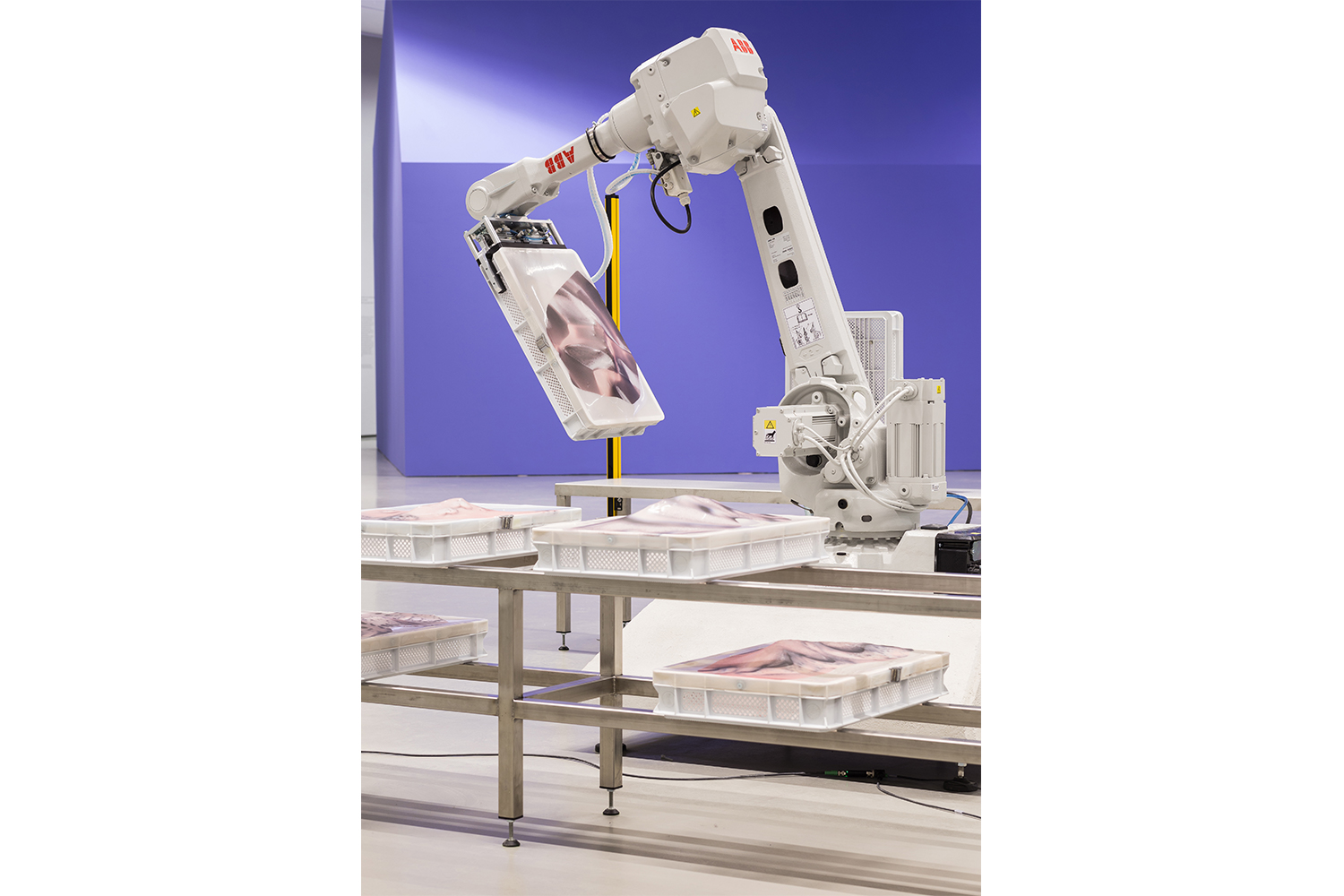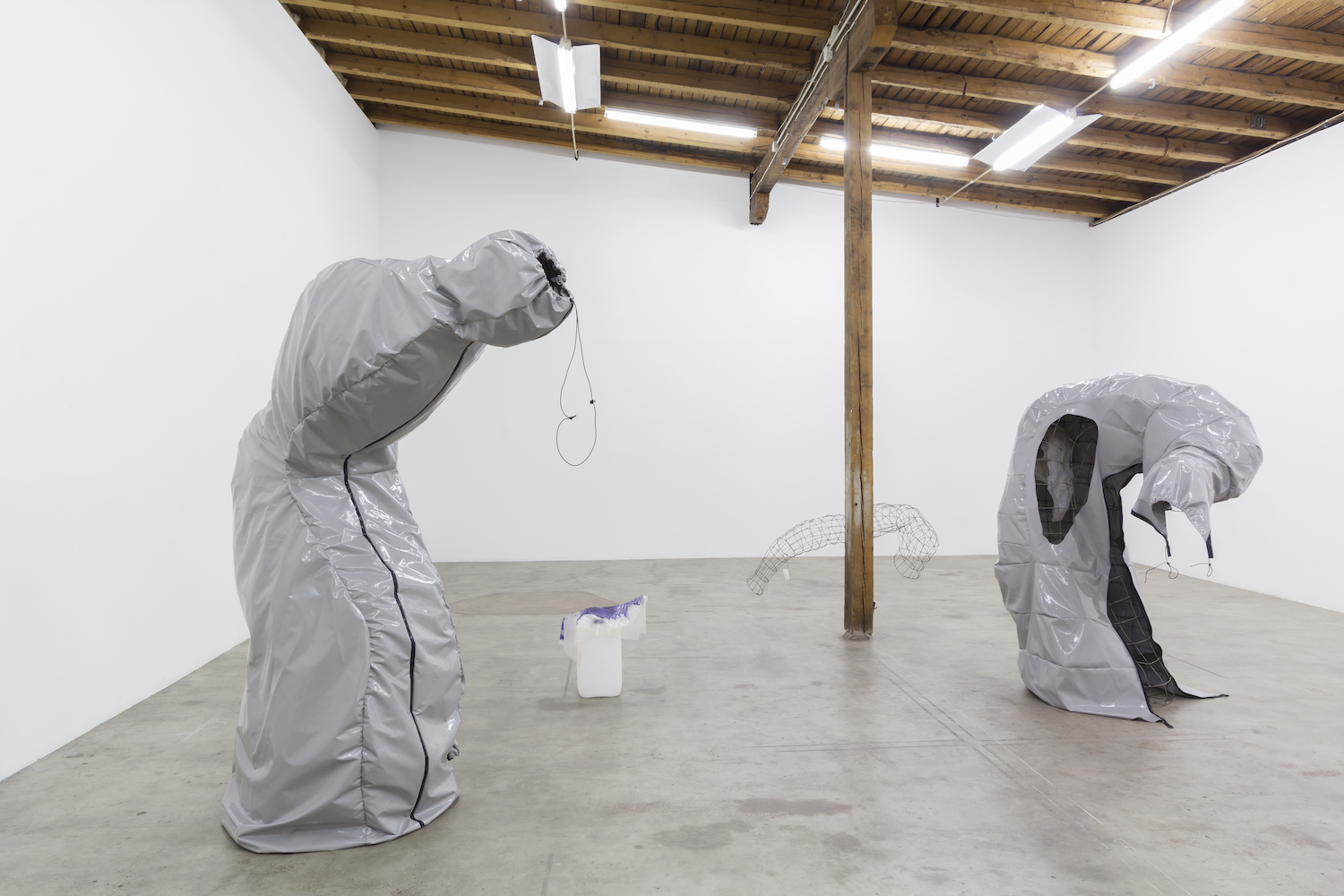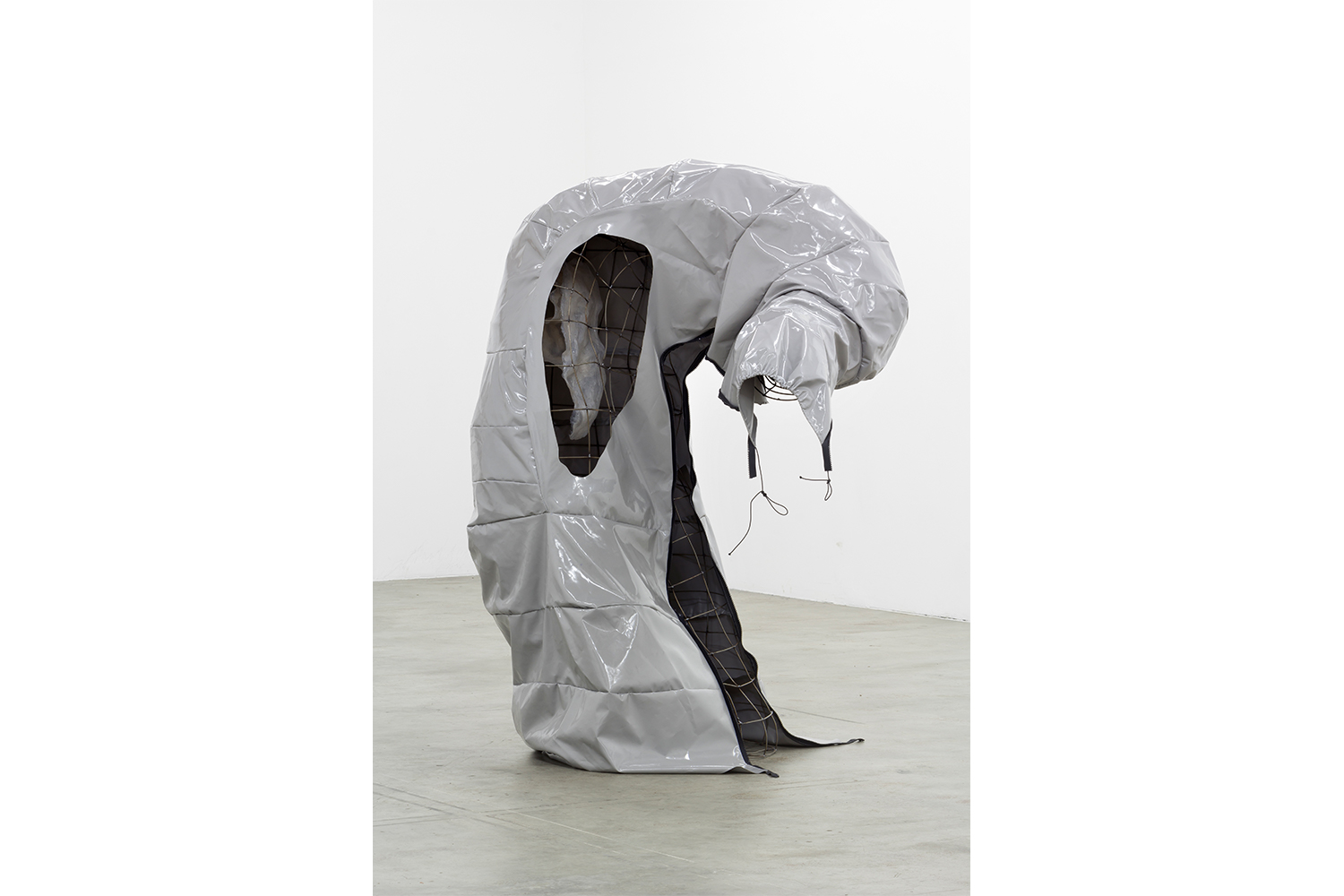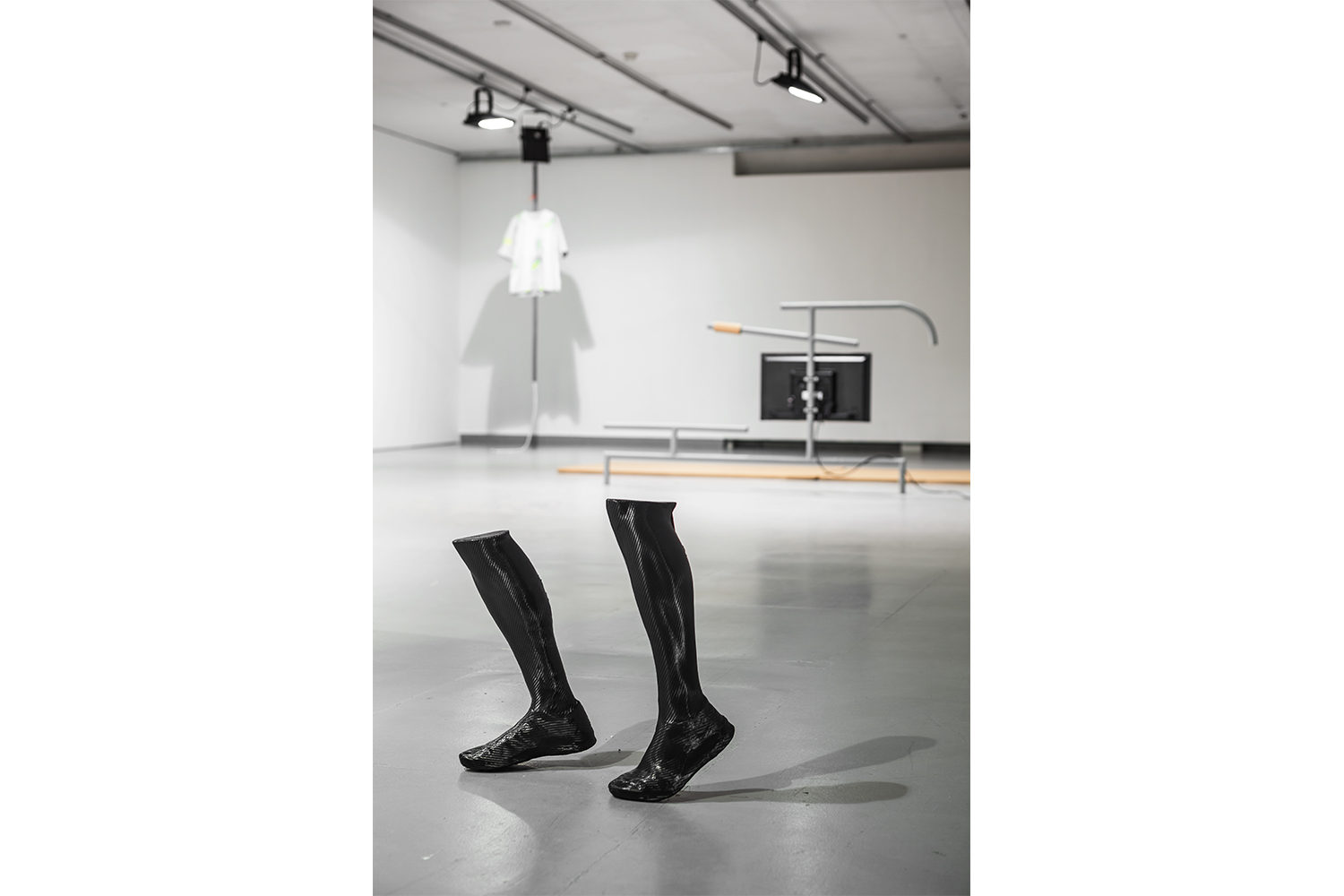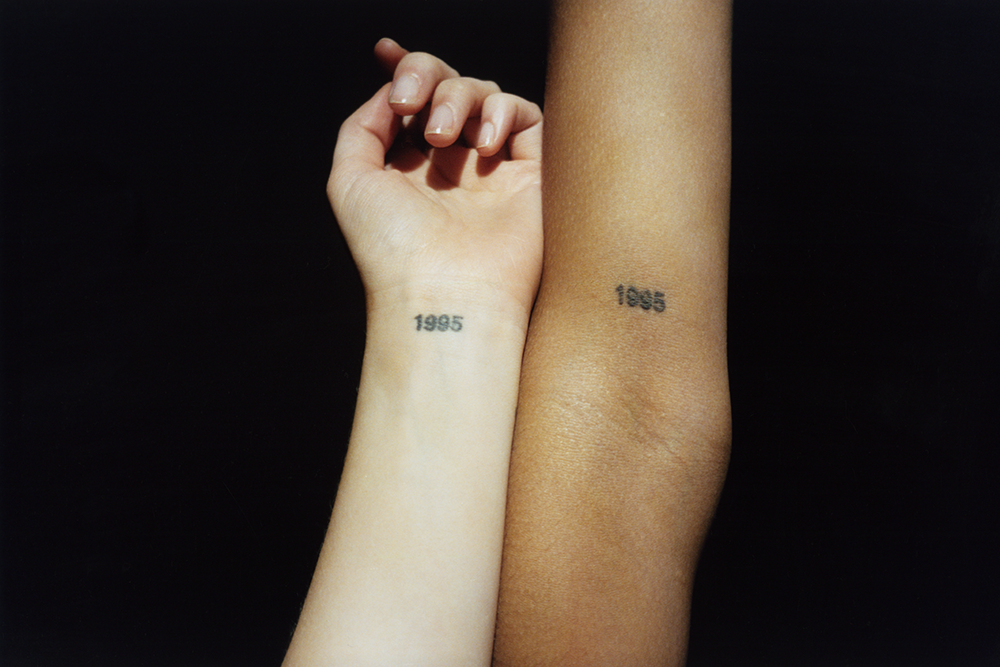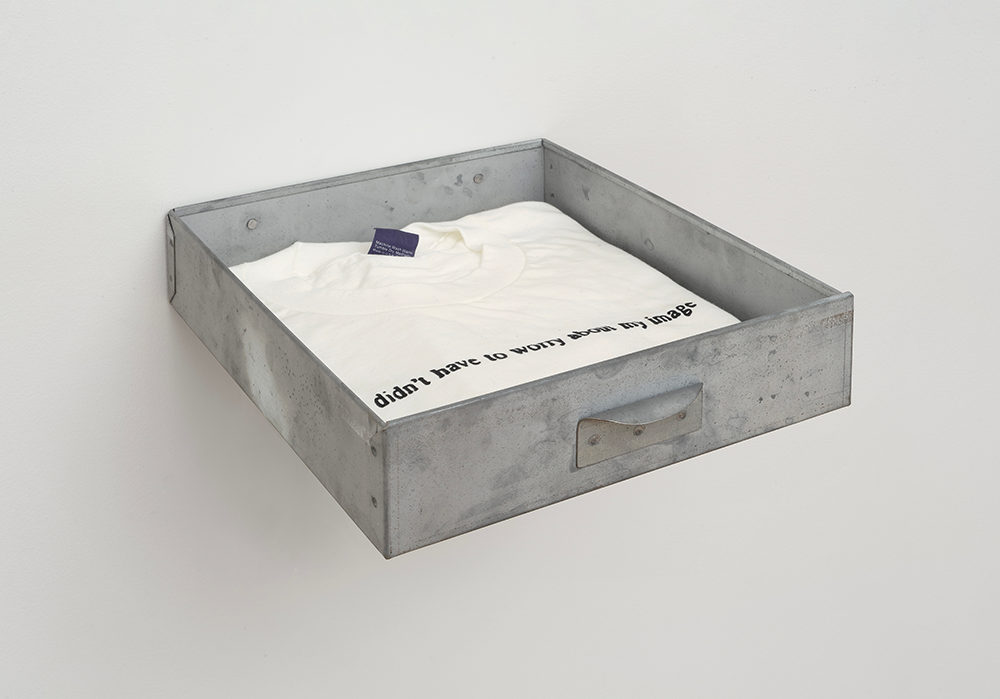With an almost uncannily timely relevance, Pakui Hardware’s most recent body of work delves into remote healthcare technologies and services: direct contact between bio-bodies is halted, not so much solely prohibited as already mediated, delegated, and automated. With “Absent Touch,” their first solo show at carlier | gebauer (2020) and “Virtual Care,” shown at BALTIC Centre for Contemporary Art at Gateshead (2021), Neringa Cerniauskaite and Ugnius Gelguda immerse the viewer — the sole fleshy human presence left to navigate the premises — in sculptural environments articulated around various constellations delineating suspended contact points of shapes, hard and soft, and textures, cold and warm. Since the Berlin-based duo’s first exhibition in 2014, this has been a recurrent fixture in their work: meaning emerges through embedded material relations rather than derivative representational semiotics.
Seen from afar, the central installation of the two shows resembles a clinical surgery room in which three articulated arms hang from the ceiling angled at a small group of three or four operating tables. On closer look, and through a situated gaze instead of a merely surveying one, a more ambiguously sensual ecosystem starts to take shape through the complexity of its parts. Terminating each ferociously sharp stainless-steel branch of the lamp sculptures is a circular blown-glass lens in yellow and orange tones, which radiates a soothing softness that immediately draws one in, as if appealing to humanity’s ancient, deep-rooted response to the presence of fire. On the tables, translucent thermoformed PET plastic shells clouded in billowy polyester fabric host fragile glass and metal elements precariously nested atop them. However technologically enhanced and abstractly simulated, they trigger a cautious ontological response to something as fragile as life suspended in precarious stasis.
Far from being triumphantly automated, an autotelic system lays bare its vulnerable workings through fragments of machines left to care for nomadic organs. Life itself is not bare anymore and probably has never been so, but vulnerability nonetheless infuses the premises. Through equilibrium and symbiosis, translated both in space and through the materials used, the Lithuanian duo’s underlying positioning is conveyed in a directly physical and almost tangible way. It is, however, less a clear positioning than an intricate involvement with technological potentialities, one that refuses grandly moral views in order to better examine use, context, and development in all their complex and ambiguous outcomes.
This is no easy task: while operating at the micro-level of an ever-evolving sensibility, political agendas and ethical implications are never left out, as the very nature of late-stage capitalism precisely implies that both cannot be separated anymore. Like an efficient tool, perhaps the most efficient of all, the invisible hand of capitalism and its many-named contemporary iterations reshapes life living and lived, human and nonhuman. As ambiguous as a process without a subject intrinsically is, robotic and digitalized care is similarly so in its outcomes for humanity. It is a way of remediating the limitations of accessible healthcare and of easing the awkwardness that sometimes arises from in-person medical exchanges. Yet short-term relief does not suppress the deeper question of how the uses of such possibilities might unfold when in the hands of capitalism — here more specifically algorithmic and data-extracting methodologies that pass off responsibility to individuals under the very guise of care.
Those recent shows are part of the duo’s long-term research on the monitoring of post-natural bodies, organs, and life forms. Previously, Pakui Hardware investigated quantified health in their show “Underbelly” at MdBK Leipzig in 2020, bariatric surgery in “The Return of Sweetness” at Tenderpixel in London in 2018, and automation through bionic robotics in “Hesitant Hand” at the National Gallery of Art in Vilnius and “Creatures of Habits” at SIC Gallery in Helsinki in 2017. As a nexus where dematerialized fluxes of subjective and machinic meet, organisms provide a fertile ground for critically examining contemporary human existence in all its murky indeterminacy. To let them flourish in their contemporary iterations and to confront them in physical space requires a change in one’s gaze: one must look at them directly, face-to-face, body-to-body, organ-to-organ, while refraining from taking comfort in the known by framing them through inherited patterns of thought or reifying them inside preexisting meaning structures.
Matter and materials are always already infused with social, political, and economic meaning. They are vibrant but they are also, to borrow Brian Massumi’s phrasing, a “sign.” The presence of a sign, the philosopher writes in A User’s Guide to Capitalism and Schizophrenia (1992), “is not an identity but an envelopment of difference, of a multiplicity of actions, materials and levels.” In a specific analysis of the woodworker’s relation to wood, he explains that when the tool meets the material, meaning arises as “the encounter of lines of force, each of which is actually a complex of other forces. The processes taking place actually or potentially on all sides could be analyzed indefinitely in any direction.” Through this example and in his writings in general, Massumi elaborates on Deleuze and Guattari’s lesser-known passages on the virtual, intensity, and sensation so as to surpass traditional philosophical dualities. Nature and culture, objectivity and subjectivity, matter and mind, raw material and production thus become entangled in a dynamic reversible process demanding each and every thing be considered in action, inside a web of complex or even at times contradictory forces.
“We must remember,” he further observes, “that the ground is ultimately unstable, and should be prepared to jump at any moment.” By putting his focus on craftsmanship, his chosen example does however leave out the specificity of artistic production and its inscription inside a specific field, adding another filter to how it relates to the world. To grasp the specificity of Pakui Hardware’s practice, one has to keep both in mind when considering how the duo relates to matter. In an interview with Ilona Dergach published in their 2021 monograph Shape Shifters, the artists stress how the realization of their “visions” remains “analog” in its hands-on work process. “By combining synthetic and organic materials,” they further explain, they “allow their own performativity to flourish […] rather than acting as some sort of creator, a transformer of material reality.” In their work, such quasi-alchemical combinations aim at the same precarious symbiotic balance as the combination of contrasting elements inside a coherent sculptural ensemble.
Take, for instance, one of the smaller and less directly perceptible parts of the main installations of “Absent Touch” and “Virtual Care.” Beneath each operating table a suspended element akin to a spongy spikey spine ends in droplets frozen midair. Its peculiar texture, neither entirely artificial nor fully organic, has been achieved from mixing a milky rubbery silicone with tiny dark chia seeds. The mixture is rich with associations to a somewhat desperate personal attempt at physical enhancement both external and internal, through implants and ingestion. As such, it already spurs the beginning of an elliptical narrative: it acts like a Hemingwayesque six-word story or like the TikTok challenge “Tell Me Without Telling Me.” Silicone and chia seeds, in fact, already appeared in “The Return of Sweetness,” which focused on engineered metabolism. To bring forth the explicitly symbolic function of materials in their website, the artists will often list them under each of their shows as a subtext to the press release. For the aforementioned: glass objects, heat-treated PVC, textile fabric, latex, sea urchin spikes, silicone, chia seeds, copper pipes, metal wires, cables, paraffin wax, neon.
Unstability, in the sense of Massumi’s “envelopment of forces,” arises in the artistic realm not only as an unavoidable correlative of a post-natural world but more specifically as the result of an intentional process. In a way, it has to be posited as a resistance to a field historically dominated by visual and representational signifying strategies. Of this, Pakui Hardware provides an interesting case study in terms of the reception of the mid 2010’s artistic and discursive context. Their first exhibition, “Metaphysics of the Runner,” held in 2014 at 321 Gallery in New York and at the Contemporary Art Centre in Vilnius, could be seen as merging two of the dominant framings of the contemporary in the Western art world at the time: on the one hand, an approach of new desubjectized materiality in resonance with a concern for “anonymous materials,” deployed through an array of manufactured items such as sports equipment and standardized shelving units; on the other, an image-based practice, using image as a found material through stock imagery printed on various flat surfaces. The latter, the image, would quickly disappear from their practice.
It is only in recent years — if not months — that we have begun to look back on the 2010s. Toward the end of the last decade they had become dated: too slick and smooth in their aesthetic texture. In retrospect, works produced at the time also came dangerously close to embracing an exhilarated linear conception of technological progress — transhumanist or techno-utopian. If the works at the time had a critical intention, a minima to try to understand the workings of technique, they got lost in the process before alternative uses could really be devised. Image-based artists of the time, especially now, appear steeped in pathos and redemption, regretting the non-indexical quality of computer-generated imagery as they watch digital entities turn to cadavers — and worse, cadavers that don’t rot. To paraphrase Ed Atkins, food in cyberspace can’t even get “old.”
In a sense, Pakui Hardware’s embodied works appear to have metabolized images to make them into material as well. Their sculptures and installations contain multiple potential images, subjected to temporality just like any other material while still retaining a certain distance through the intentional act of producing or reshaping it. But those images, the not-fully-digested part of them still active from inside the assemblages, the ones that contribute to the sparking of narrativity, are also what allows the duo’s work to avoid another pitfall. In a vast array of present-day works based on a simplistic or blindfolded reading of the “anonymous materials” tradition, relativism looms when artworks simply restrict themselves to a fascinated approach to organic, even if contaminated, materiality without including imagery, however metabolized, in the process.
To look at real “old food” or at synthetic materials rotting away is just as bleak a prospect as siding solely with images: in both cases, one loses the potential narrativity and, even more significantly, the possibility to participate in an act of reshaping alternative modes of agency. As such, Pakui Hardware’s practice can only appear as timely as it does because it embraces both sides at once, following material’s performativity while still believing that it is possible, through art, to intervene in its assemblage so as to diversify its uses, meanings, and narratives. It is an act of collaboration, emancipatory as well, in that by letting polysemy flourish, it ultimately surpasses our time’s two dead ends: that there should be no alternative to capitalism’s self-perpetuating zombie imagery, and that by becoming a murky thing among other murky things, one, fatally, has to accept relativism as a casualty.

